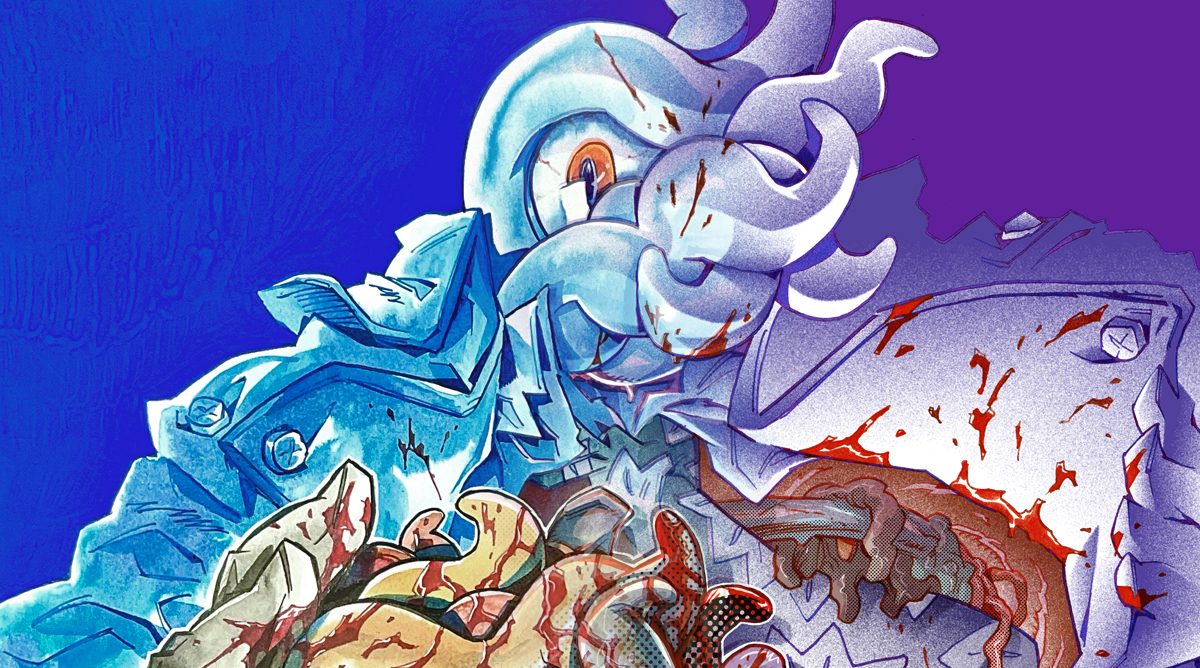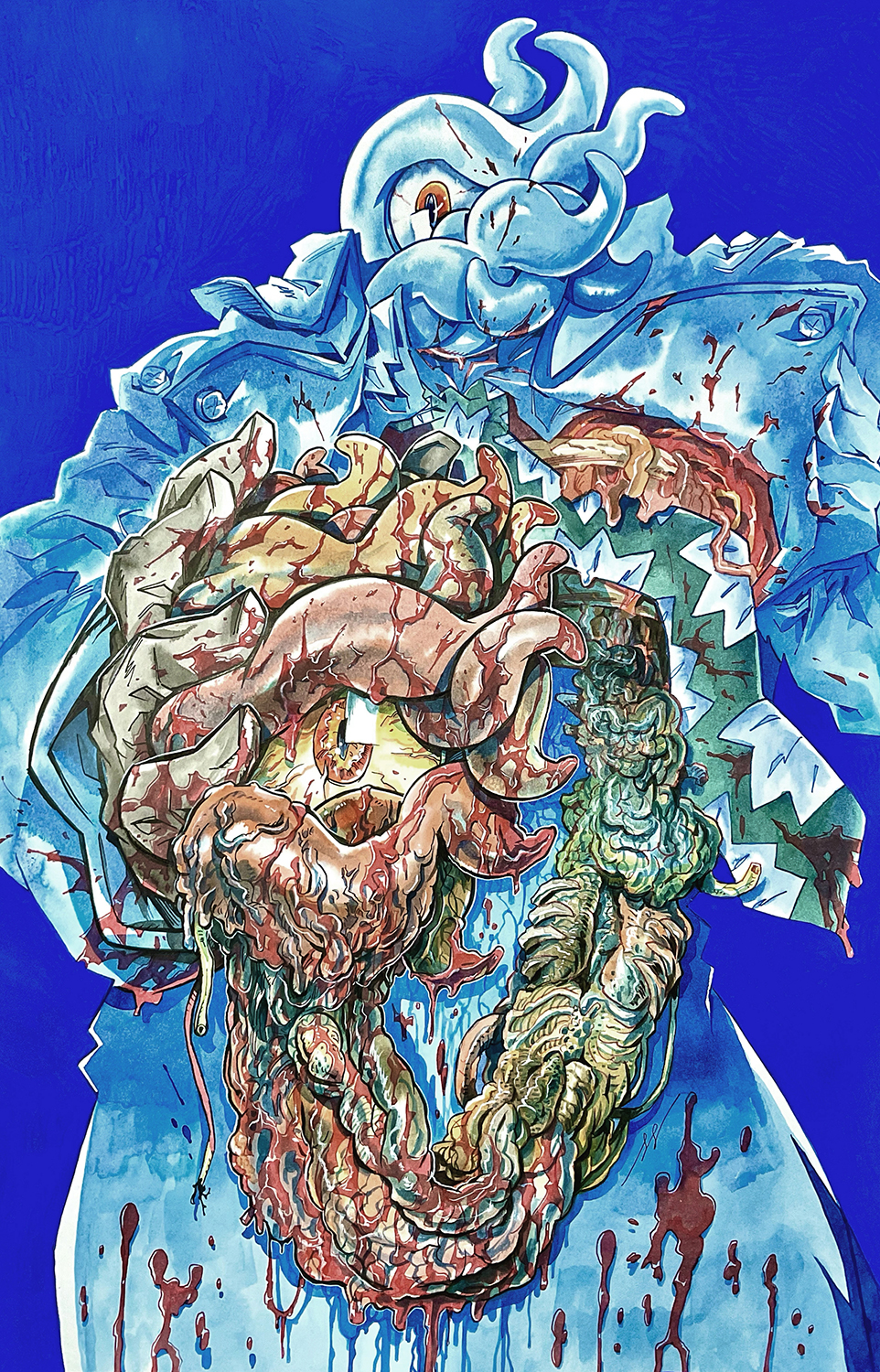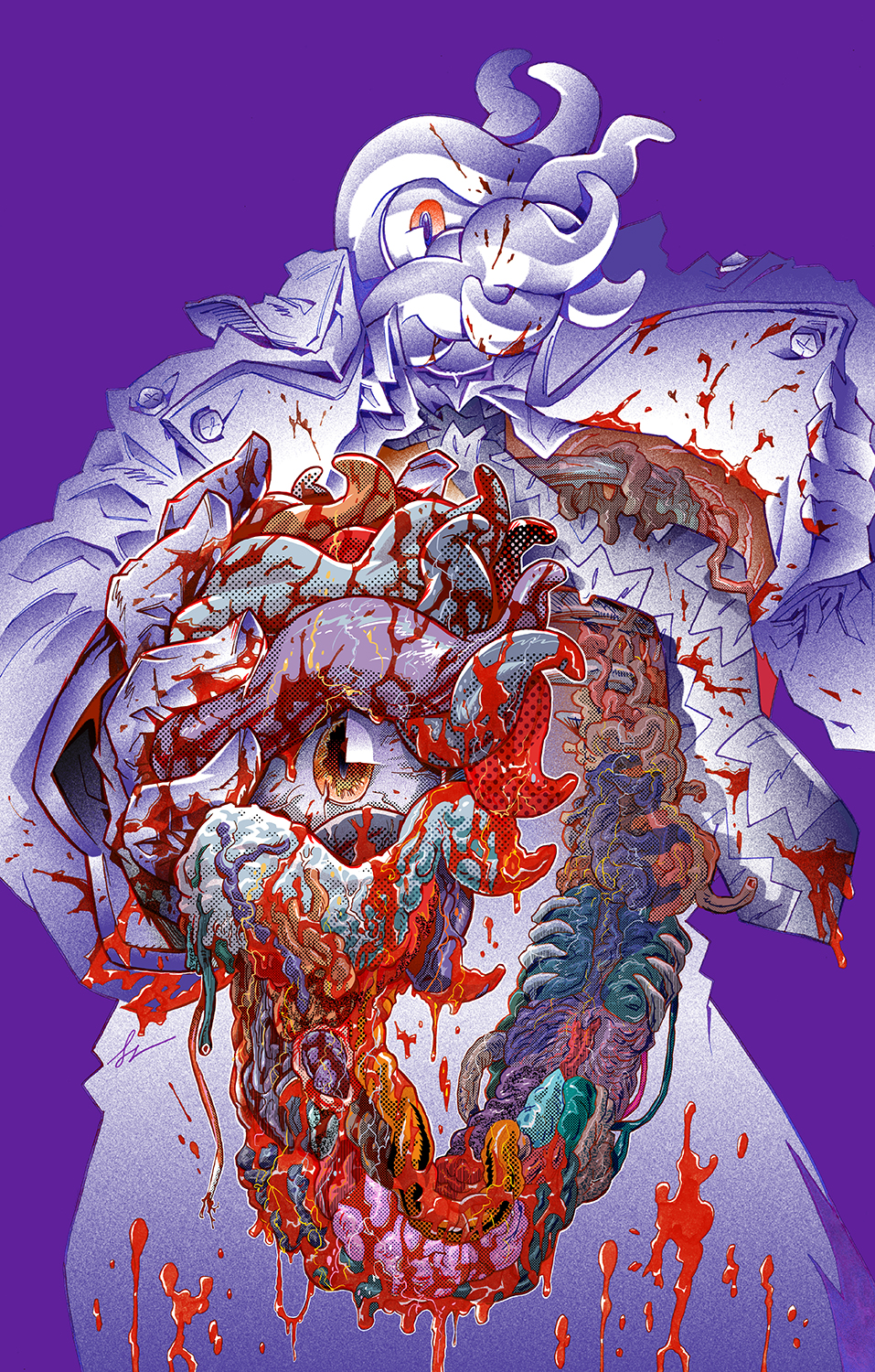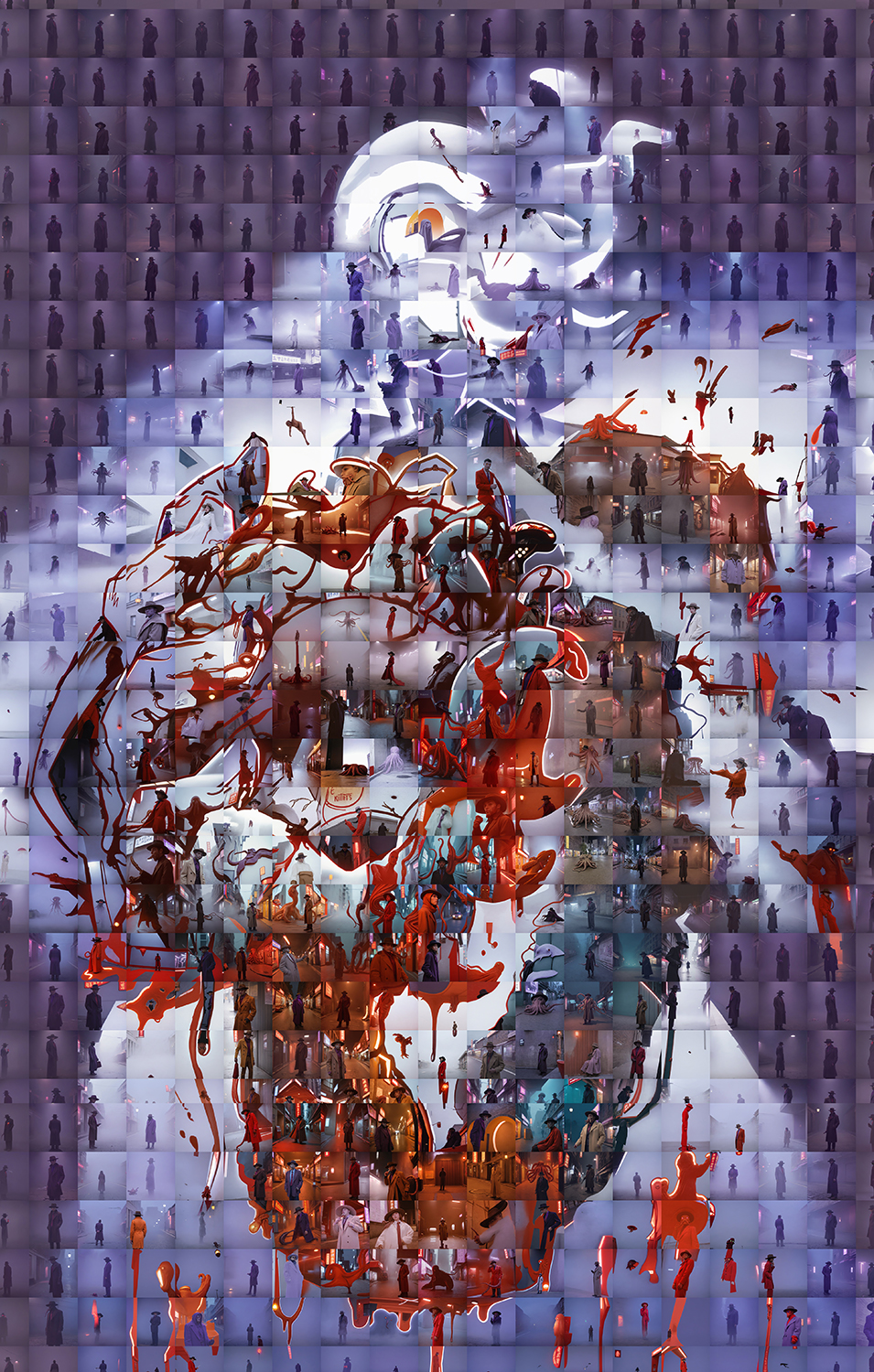
Faculty of Digital Art, Rangsit University
Suttichart Sarapaiwanich



Abstract :
Nowadays, the rapid development of technology impacts every aspect of daily life. In the field of illustration, AI technology can create high-quality artwork in the blink of an eye. How can illustrators compete with this advancement? Some see AI as a new tool that can assist artists, while others have lost their jobs because of it.
This project is inspired by an AI creator in Thailand who organized the exhibition Synthetic Muse 2.0. The exhibition begins with original artworks created by artists, which are then transformed by an AI creators before being displayed. The illustration Good_at_Hurt was created based on the theme: “Where the hurt happens is where the art happens.” This project uses a character from the comic JOE the SEA-CRET Agent to depict this theme, showing him posed as if pulling his heart from his chest to reveal his pain. The original artwork was created in two styles—analog and digital—before being transformed into an AI-generated version by the AI creator team Vulcan X and exhibited alongside the original pieces.
When all the artworks are displayed together, a question arises: Which one represents the past, present, or future of illustration? This project aims to invite the audience to reflect and decide for themselves. Perhaps the answer will reveal itself to someone, somewhere, someday—or perhaps it never will.
Objectives :
The objective of this project is to explore, observe, and compare various illustration techniques across analog, digital, and AI-generated art. By analyzing differences in style, process, and impact, the project aims to highlight the strengths and limitations of each medium. Additionally, it seeks to create artworks that challenge perceptions of time and progress in illustration by asking, “Which one represents the past, present, or future of illustration?” Through experimentation, the project will develop a mixed-media exhibition that seamlessly integrates traditional illustration methods with cutting-edge digital and AI-driven approaches. This exhibition will serve as both a creative and educational platform, fostering discussion on the evolution of artistic tools and techniques while engaging audiences with a dynamic, visually compelling experience.
Conceptual Framework :
Nowadays, the rapid development of technology impacts every aspect of daily life. In the field of illustration, AI technology can generate high-quality artwork in the blink of an eye. How can illustrators compete with this advancement? Some see AI as a valuable tool that assists artists, while others have lost their jobs because of it.
The emergence of AI technologies, such as text-to-image models, has transformed the way people think about art and design. Now, anyone can create high-quality images simply by inputting a set of keywords, allowing AI to generate results within seconds. This shift is as disruptive to the art world as Marcel Duchamp’s Fountain was in its time. Eric Zhou and Dokyun Lee suggest that the future of human creativity will focus on artistic proficiency and refined aesthetic judgment rather than purely mechanical skills (Zhou & Lee, 2024, p. 52). However, Bellaiche, Shahi, and Turpin argue that people connect with art through human-specific experiences. Their research found that audiences who valued both human-made and AI-generated art still exhibited a negative bias toward AI-created works (Bellaiche, Shahi, & Turpin, 2023, p. 42).
Eva Jäger, the creative AI lead and arts technologies curator at the Serpentine Gallery in London, predicted that both traditional and AI-generated art will continue to develop in their own ways. She believes that humans will benefit from AI art, as it enables them to create better art than ever before (BBC, 2024, October 18). Similarly, Gjorgjieski concluded in his article on the relationship between traditional and AI art that AI has expanded the boundaries of human understanding of art into new, undiscovered areas. AI has the potential to revolutionize how we create, consume, and interact with art (Gjorgjieski, 2024, pp. 49–60).
Process / Methodology :
This project began with an invitation from a Thai AI creator group organizing the exhibition Synthetic Muse 2.0. The exhibition starts with original artworks created by human artists, which are then transformed by AI creators before being displayed side by side. It will be held at BACC from December 24, 2024, to January 12, 2025.
To develop the original artworks, this project adopted the theme: “Where the hurt happens is where the art happens.” Using a character from the comic JOE the SEA-CRET Agent, the project visually explores this theme. The character is depicted in a dramatic pose, seemingly pulling his heart from his chest to expose his pain in the piece titled Good_at_Hurt. The artwork was created in two styles—analog and digital—before being transformed into an AI-generated version by the AI creator team Vulcan X and exhibited alongside the original pieces, posing the question: Which one represents the past, present, or future of illustration?
Techniques and Materials :
This project separated the artwork Good_at_Hurt from the Synthetic Muse 2.0 exhibition into three distinct pieces for display at the RSU 13th Symposium. Each piece represents a different stage in the evolution of illustration—traditional, digital, and AI-generated—highlighting the transformation of artistic techniques over time.
1. Past_Hurt
This piece represents traditional art, created by hand-painting with ink and color on paper in a comic/manga style. It emphasizes the craftsmanship and tangible qualities of analog illustration.
2. Present_Hurt
This version is a digitally colored adaptation of Good_at_Hurt, printed on museum-grade paper for exhibition. It demonstrates modern digital illustration techniques while maintaining the essence of hand-drawn artistry.
3. Future_Hurt
This AI-generated version was created by the AI creator team VulcanX, using the digital artwork of Good_at_Hurt as inspiration. The AI-generated piece reflects the fusion of human creativity and machine learning. Additionally, this version was developed into a motion graphic to represent contemporary digital techniques, showcasing the potential of AI in animation and dynamic visual storytelling.
By exhibiting these three versions side by side, this project invites discussion on the evolving role of technology in art and challenges audiences to reflect on which medium best represents the past, present, or future of illustration.
Result / Conclusion :
After exhibiting both versions of Good_at_Hurt alongside various AI-generated artworks in Synthetic Muse 2.0, observations of audience reactions and discussions with creators revealed the enduring value of original ideas developed through traditional artistic methods. The integration of AI-generated processes expanded creative boundaries, influencing both the early conceptual stages and the final execution of artworks. This experience felt like working with an immense creative team—not just a handful of colleagues, but millions—while significantly reducing production time.
The unique artworks resulting from the collaboration between human artists and AI creators also addressed concerns about copyright and licensing, offering a new approach to both traditional and digital art. This collaboration demonstrated how AI can be a tool that enhances, rather than replaces, artistic expression.
Regarding the question, “Which one represents the past, present, or future of illustration?”, the project’s creator concluded that each artwork can represent all three, depending on individual perspectives. Just as human art has evolved across different eras, the interpretation of these works varies based on personal experiences, cultural contexts, and artistic viewpoints, reflecting the continuous and dynamic nature of illustration.
References :
Eric Zhou, Dokyun Lee, Generative artificial intelligence, human creativity, and art, PNAS Nexus, Volume 3, Issue 3, March 2024, pgae052, https://doi.org/10.1093/pnasnexus/pgae052, Available at SSRN: https://ssrn.com/abstract=4594824 or http://dx.doi.org/10.2139/ssrn.4594824
Bellaiche, L., Shahi, R., Turpin, M.H. et al. Humans versus AI: whether and why we prefer human-created compared to AI-created artwork. Cogn. Research 8, 42 (2023). https://doi.org/10.1186/s41235-023-00499-6
BBC. (2024, October 18). AI art: The end of creativity or a new movement. BBC Future. https://www.bbc.com/future/article/20241018-ai-art-the-end-of-creativity-or-a-new-movement
Gjorgjieski, V. (2024). Art Redefined: AI’s Influence on Traditional Artistic Expression. International Journal of Art and Design, 1(1), 49-60 https://doi.org//10.69648/SWWW723